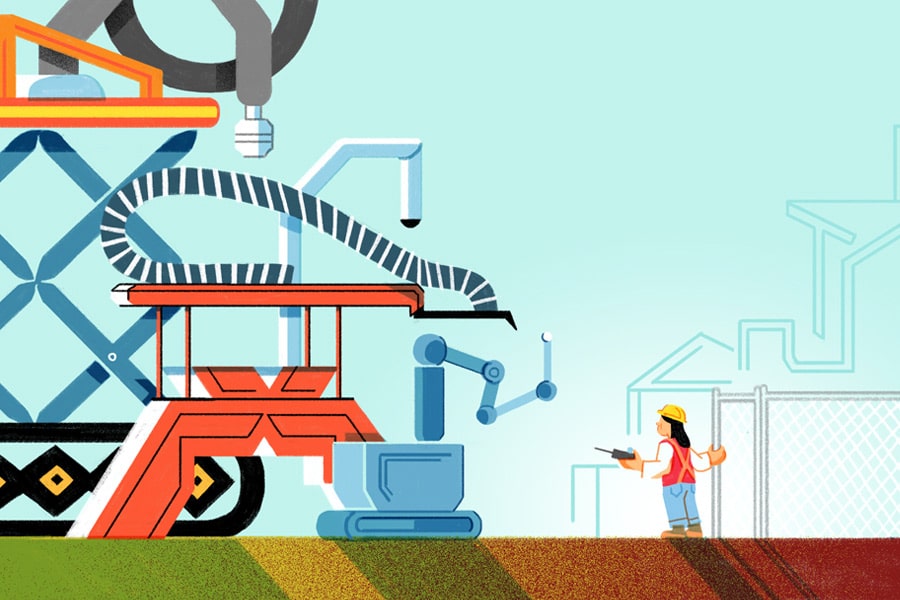Illustration by Wenting Li
The construction industry is facing a myriad of challenges: a skilled construction worker shortage, materials and supply chain logjams, low profit margins, pressure to be less resource intensive—all on top of the gigantic task of making the industry more environmentally sustainable.
These challenges come as the industry also confronts a bevy of big-picture issues.
Commercial builders face an uncertain future, as the growth in permanent remote and hybrid work—among other trends spurred by the COVID-19 pandemic—threatens to upend construction centered around office buildings and the retail and hospitality building that often comes with it.
On the residential side, contractors need to build an estimated 3.8 million single-family homes to catch up with existing demand, but a persistent supply chain crisis is forcing homebuilders to find alternative materials.
It would seem like the industry is due for a major innovation. Might that come in the form of construction robots?
Tom Woodman, executive director of Citizen Robotics, a nonprofit educating communities about 3D-printed homes, said robotic solutions, along with the rise of additive manufacturing, could go a long way toward helping the residential building sector in particular.
“We need to reach for another construction method using the tools and techniques from advanced manufacturing,” Woodman said, “and bring more tools to the toolbox for the modern-day construction workforce.”
Proponents say robotics brings predictability to an industry rife with uncertainty. Every day, project teams are faced with challenges on every construction site. With construction robots doing more of the building, however, “costs are more predictable, schedules are more predictable; we can use repetitive processes where possible; and then we can actually start to bring down the cost,” said Ramtin Attar, co-founder and CEO of Promise Robotics, a company specializing in panelized construction.
State of the industry
Robotics and automation in the construction industry may go a long way toward solving a number of construction’s more persistent problems, from the skills gap to the need to hire a younger and more diverse workforce.
ABB Robotics conducted a survey earlier in 2021 about the use of robotics in the construction industry. The company asked 1,900 construction businesses around the world about the industry’s need for workers and their use of robotic solutions.
ALSO ON BUILT:
Overwhelmingly, respondents felt the industry was headed toward a construction skills gap crisis by 2030. Already, construction firms are struggling to find workers—there were more than 311,000 construction vacancies in the U.S. in the second quarter of 2020.
Companies were also asked in the survey if they were looking into possibly using robotics in the next 10 years; 81% said they were, while 55% said they already use robots, mostly to increase safety and sustainability on jobsites.
“It’s amazing that when you go meet with people in other industries that are using robotics, like health care, automotive and logistics, they’re just amazed that the construction industry has not adopted robotics yet,” Attar said.
The changing nature of construction jobs
As construction robots become more prevalent, the nature of the jobs available in the industry is likely to change. Laborer and installer positions will be replaced with robot operators—a role likely to require skills in software programming, mechanics and troubleshooting, and one without the same level of physical demands as more traditional construction jobs.
Moreover, there will be less of a need for site workers altogether and more need for technicians, robot assemblers and programmers as more construction moves to a warehouse/production line model, as seen with modular building.
Industry experts say this potential changing nature of construction jobs is likely to help the industry’s current struggle with attracting young talent more intent on working in technology-related fields.
Some companies have already begun to make this transition by attracting workers interested in robotics. Autovol, a modular building supplier, has brought in several younger workers as robot operators. Not only are its employees younger, but they are more diverse.
“Today our plant’s 33% female,” said Rick Murdock, Autovol’s co-founder and CEO. “And a large part of that is due to the automation process, because we have a lot of female operators, finishers and so forth.”
Moving jobs from the jobsite to the warehouse also addresses some of the reasons construction is so cyclical. Weather and temperatures can be controlled in a warehouse, unlike the jobsite. Production can go on year-round, meaning workers are employed year-round as well.
Is robotics the answer?
Still, these companies continue to have to sell the advantages of robotic production to an industry already known for its skepticism toward new technology. Most see the only barrier to growth as the adoption of the technology. As the advantages of robots in construction are seen less as an anomaly and more pervasive, experts say there will be more demand for the technology in the industry.











